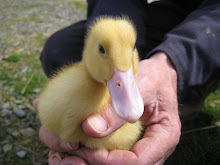
I have deliberately avoided posting about
badgers for a very long time; their mention generates such strong feelings for both conservation and culling, especially here in Devon, which is a
TB hotspot.
The case against the badger being the source of infection for TB in cattle is continually
proved and
disproved. To a non-scientist this is a very live case of bad science
. Would I be naive in imagining that politics and self-interest groups were badly interfering with independent, rigorous research here? Why is the answer so difficult to ascertain? Meanwhile cattle farmers live with the very real consequences of TB, and others flinch at the prospect of a potentially unwarranted cull.
There is an active badger sett on the farm. It sits in a remote spot, and the inhabitants quarry huge amounts of stone and shingle to continuously improve their home. They are fearsomely strong and persistent animals; no fence I know of can keep them in or out, so you don't even try. The entrance holes to the sett are big enough to swallow a toddler or a rugby player's thigh, and a few yards away you'll find used bedding, dry grasses for the most part, turfed out regularly. When the ground is soft the impression made by their claws requires respect, and you really don't want your dogs to meet them snout to snout.
Their overactive toileting habits have always made me chuckle; they dig shallow scrapes a short distance away from the sett which they then proceed to fill beyond the brim. In the autumn these mounds are full of plum, damson and sloe stones.
It is the beauty and strangeness of the badger which is so appealing. They remind me of the
tapir, a particular favourite from a time when I drove past some every day
on the way to work (pdf), even though they are not
odd-toed ungulates and therefore in a completely different category. Even so, both have the camel-like association of being an animal designed by committee. The badger's markings are as extraordinary as a zebra's stripes and they beetle about in an inelegant and apparently casual manner that belies their natural sense for self preservation, although I suspect their poor eyesight has something to do with that.
I have tripped over badger cubs in the middle of the day, seen Mopsa pounce on a moving heap of leaves to reveal not the mouse we were both expecting but a young badger who moved swiftly off the scene, and heard badgers fighting at night - the most ferocious sound.
I can't help but hope that the badgers here are free from both TB and legislative danger.
 Did millions of viewers watch Siralan Sugar's Gerald Ratner moment last night? Did we really see Claire's victory tossed carelessly to a proven liar?
Did millions of viewers watch Siralan Sugar's Gerald Ratner moment last night? Did we really see Claire's victory tossed carelessly to a proven liar?













